How to Make Money with AI Photography
Hey there, fellow shutterbugs! It’s your favorite AI-obsessed photographer here, ready to spill the beans on how to use Artificial Intelligence to make money in photography. I know, I know – I used to be the loudest anti-AI voice in the room. But then I realized: if you can’t beat ’em, join ’em (and make some cash while you’re at it)!
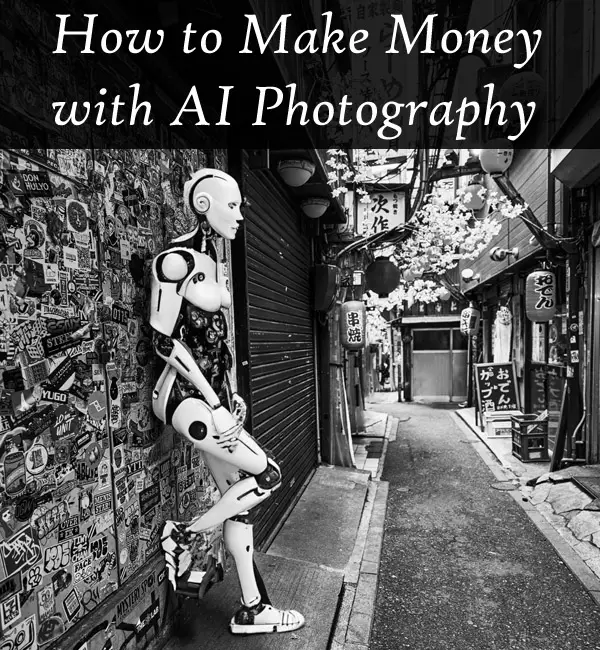
So, I dove headfirst into the world of AI-generated/modified images, and let me tell you, it’s been a game-changer. No more hours spent editing and retouching – now, I can create stunning, sellable images with just a few clicks. And the best part? The money’s rolling in like never before.
Ready to join the AI revolution and start raking in the dough? Let’s get started!
How to Make Money with AI-Generated Photography
AI art is taking the world by storm. And if you’ve got a knack for creating stunning visuals with AI tools, you might be wondering how to turn your passion into profit. Well, I’ve got good news for you. There are plenty of ways to monetize your AI-generated photography skills. But before we dive into the juicy details, let’s make sure we’re on the same page about what AI image generation is all about. AI image generation is a fascinating process. It involves using artificial intelligence algorithms to create images from scratch. These AI tools are trained on massive datasets of images and text, allowing them to learn the associations between words and visual concepts. Once the AI model has been trained, you can feed it a text prompt or a combination of text and images, and voila. It generates a brand new image based on your input. It feels like you’ve got your own digital Picasso at your command.
Benefits of Using AI for Photography
Now, you might be thinking, “Why should I bother with AI photography when I can just take photos myself?” Well, there are several compelling reasons:
1. Speed: AI image generation is incredibly fast. You can create multiple variations of an image in a matter of seconds, saving you hours of shooting and editing time.
2. AI tools are like a creative buddy, throwing out fresh ideas and directions you might not have dreamed up by yourself. It’s like having a brainstorming partner that never runs out of steam.
3. Cost-effective: With AI, you don’t need to invest in expensive camera gear, studio space, or props. All you need is a computer and an AI tool, and you’re ready to create.
4. Versatility: AI-generated images can be used for a wide range of purposes, from social media content to product mockups to book covers. The possibilities are endless.
Legal Considerations
Before you start selling your AI-generated photos, it’s crucial to understand the legal landscape. While the laws around AI art are still evolving, there are a few key things to keep in mind:
1. Copyright: In most cases, you own the copyright to the AI-generated images you create. However, it’s essential to check the terms of service of the AI tool you’re using to ensure you have the right to use the images commercially. This also depends on whether another photo was used to generate it.
2. Model releases: If your AI-generated images feature recognizable people, you may need to obtain model releases before using them for commercial purposes. This is to protect the privacy and publicity rights of the individuals depicted. 3. Trademarks: If your AI-generated images include trademarked logos or products, you’ll need to obtain permission from the trademark owner before using them commercially. Getting a grip on these legal tips means you’re not just playing it safe with your AI-generated photos—you’re also making sure everything’s above board and respectful.
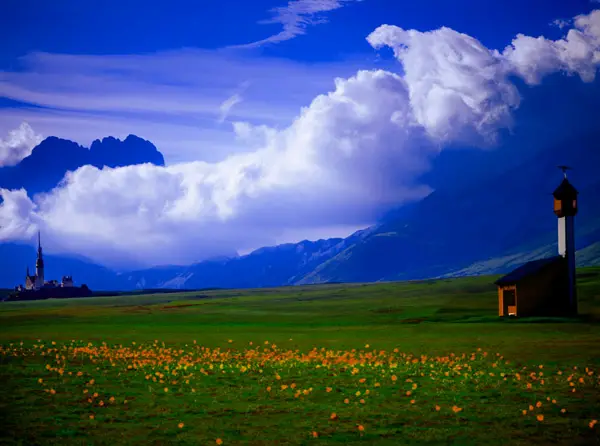
Top Ways to Monetize Your AI-Generated Photos
Alright, now that we’ve covered the basics, let’s get to the fun part: making money with your AI-generated photos. Here are some of the top ways to monetize your skills:
Selling Stock Photos
One of the most straightforward ways to make money with AI-generated photos is by selling them as stock photos. Stock photography websites like Shutterstock, Getty Images, and Adobe Stock are always on the lookout for fresh, high-quality images to add to their collections. To get started, create a portfolio of your best AI-generated photos and submit them to these stock photography platforms. Don’t forget to sprinkle in those catchy keywords and vivid descriptions, so your photos pop up for the right buyers. When someone licenses one of your photos, you’ll earn a percentage of the sale price. The exact amount varies depending on the platform and the license type, but it can add up over time.
Turning those digital pics from your AI into physical items people can buy on-the-spot is yet another clever path to pocketing some earnings. Websites like Society6, Redbubble, and Zazzle allow you to upload your designs and sell them on a variety of products, from t-shirts and mugs to phone cases and wall art. With print-on-demand, say goodbye to the hassle of keeping track of inventory or handling shipping nightmares. When someone orders a product featuring your design, the platform handles the production and fulfillment for you. You simply earn a commission on each sale. To maximize your earnings, create designs that appeal to specific niches or trends. For example, you could create a series of AI-generated space landscapes for science fiction fans, abstract patterns for home decor enthusiasts, or your photo landscapes modified with AI to make people question if they can be real- true conversation pieces.
Custom Commissions
If you’ve built up a following for your AI-generated art, you might consider offering custom commissions. This involves creating personalized images for clients based on their specific requests. For example, a client might ask you to create an AI-generated portrait of their pet or a unique logo for their business. You can charge a premium for these custom projects, as they require more time and effort than generic stock photos. To get started with custom commissions, create a portfolio website showcasing your best work and outlining your commission process. You can also reach out to potential clients directly through social media or email marketing. Licensing your AI-generated images for commercial use is another route you can take to earn money. This method lets businesses or individuals pay you a fee to use your images in their own work—like in an ad, a presentation, or any other project they have. It’s pretty straightforward: your images become a part of their story, and you get paid for it. To get started, choose images you’ve made that you think have a wide appeal. High-quality, versatile images do best, as they can fit into different settings, like office life, tech, or wellness. Upload these images to platforms where folks look for photos to license. Add clear descriptions and relevant tags to each picture so it pops up when they search.
Creating NFTs
Lately, NFTs have been making waves in the art scene like never before. In today’s market, creators can make a pretty penny by offering unique digital pieces that collectors are jumping at the chance to snatch up. If you’re interested in exploring the world of NFTs, you can create AI-generated art specifically for this market. Platforms like OpenSea, Rarible, and Nifty Gateway allow you to mint your own NFTs and sell them to collectors. Keep in mind that the NFT market can be volatile, and success is not guaranteed. It’s essential to do your research and understand the risks before diving in. If you’re pretty good at whipping up images with AI, how about passing on that wisdom?
Creating Courses
Developing an online course on AI photography can be a lucrative way to monetize your skills. Think about crafting a learning path where we start with simple AI picture making methods and gradually tackle more complex strategies and processes. Platforms like Udemy, Skillshare, and Teachable make it easy to create and sell your course to a global audience. To make your course stand out, focus on providing practical, actionable advice that students can apply to their own work. You can also offer personalized feedback and support to help students achieve their goals.
Writing eBooks or Blogs
Another way to share your AI photography knowledge is by writing eBooks or blog posts. If you have a talent for explaining complex concepts in a clear and engaging way, this could be a great option for you. You can write about a wide range of topics related to AI image generation, from tutorials and case studies to opinion pieces and industry news. By building a loyal following of readers, you can monetize your content through advertising, affiliate marketing, or direct sales of your eBooks. To get started, choose a niche that aligns with your expertise and interests. Moving forward, let’s pencil in some dates for when you’ll drop some killer content everyone will want to read – stick with it consistently.
Creating Tools
If you have a background in software development (or know how to use AI for coding), you might consider creating your own AI-powered photography tools. These could be plugins for popular editing software like Photoshop or standalone applications that help users generate unique images. Handing over these powerful tools to both photographers and designers could be your ticket to consistent earnings. It’s like hitting two birds with one stone—you earn on repeat and establish yourself among the top names in artificial intelligence for photography. You can sell your software directly through your own website or through marketplaces like the Adobe Creative Cloud.
Creating Headshots
You may have seen online companies like HeadshotPro which eliminate the need for any studio time for the client. I am not for this completely, however, you can use AI to make headshots hyperreal, modified, do headshots of people who cannot pose for whatever reason, create headshots for deceased people, to bring families together again, have people together who live far apart or cannot afford to travel, etc. This is also nearly instant as opposed to traveling to a good photographer and setting up an appointment, especially if outdoor settings are needed in specific seasons. You can also use AI to modify existing shot backgrounds, edit items in photos, etc. The options are endless.
Providing Consulting Services
As AI photography becomes more mainstream, there will be a growing demand for experts who can help businesses and individuals navigate this new landscape. If you have a deep understanding of AI image generation and its applications, you might consider offering consulting services. This could involve helping clients develop an AI photography strategy, training their teams on best practices, or providing guidance on legal and ethical considerations. You can offer your services on a project basis or through ongoing retainer agreements. First up, launch a site where you can flaunt your know-how and spell out the details of the consulting work you do. You can also reach out to potential clients directly through LinkedIn or other professional networks.
Becoming an Influencer
Think about it – with a solid personal brand and a flair for engaging posts, becoming an influencer in AI photography could be your next big move. This involves building a following on social media platforms like Instagram, TikTok, or YouTube and partnering with brands to promote their products or services. As an influencer, you can monetize your content through sponsored posts, affiliate marketing, or by selling your own products or services. To be successful, it’s essential to create authentic, valuable content that resonates with your audience and aligns with your personal brand. Kick things off by picking a platform that feels right for what you’re good at, then dive into making stuff regularly. Engage with your followers and collaborate with other influencers to grow your reach and credibility. In conclusion, there are countless ways to monetize your AI-generated photography skills.
Selling stock photos, launching print-on-demand goods, taking custom orders, or stepping into the influencer world—what matters is picking a lane that plays to your strengths and sparks joy for you. By staying up-to-date with the latest trends and technologies, and by consistently creating high-quality, valuable content, you can build a successful career in the exciting world of AI photography. So what are you waiting for? Start exploring these monetization strategies today and turn your passion into profit.
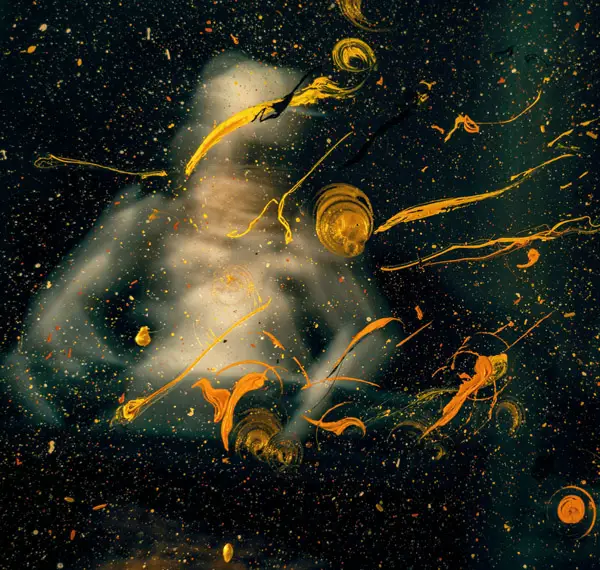
Tips for Creating High-Quality AI-Generated Images
AI image generators are powerful tools, but they’re not magic wands. Trust me, I’ve spent countless hours tinkering with prompts and settings to get the results I want. It takes some trial and error to master the art of AI image creation. First things first, you need to pick the right AI art generator for your needs. There are tons of options out there, each with its own strengths and weaknesses. Personally, I’m a big fan of Midjourney. Easy peasy for anyone to get the hang of it, this platform is surrounded by a vast creator community that keeps dazzling us with beautiful images. Plus, their Discord server is always buzzing with helpful tips and inspiration. But don’t just take my word for it. Do your research, try out a few different generators, and see which one clicks with your creative vision.
Crafting Effective Prompts
Now, let’s talk about prompts. This is where the real magic happens. Your prompt is the key to unlocking the full potential of AI image generation. A prompt is your input in an AI system, it can be a question, an example, a statement. The main thing is that your particular AI system understands your prompts so look at examples provided. The more specific and descriptive your prompt, the better the results. Don’t just say “a cat.” Say “a fluffy orange tabby cat with green eyes, lounging on a windowsill, basking in the sunlight.” Paint a picture with your words. I like to think of prompts as a collaboration between human and machine. You provide the vision, the AI brings it to life. It’s a beautiful partnership. But crafting the perfect prompt rarely happens on the first try. It’s an iterative process. If your initial results aren’t quite hitting the mark, don’t get discouraged. Tweak your prompt, get more specific, try different angles. I can’t tell you how many times I’ve gone back to the drawing board, refining my prompts until I get that “a-ha.” moment. You know, crafting masterpieces is all about these moments right here.
Upscaling Techniques
Once you’ve got a solid base image, it’s time to level up with some upscaling techniques. This is your golden chance to let the AI art you create really pop and grab attention. Tools like Gigapixel AI and Topaz Labs can help you boost the resolution and sharpen the details of your images. It’s like giving your art a superhero serum. But be careful not to overdo it. You want to enhance the image, not distort it. Find that sweet spot where the details sing, but the integrity of the original vision remains intact.
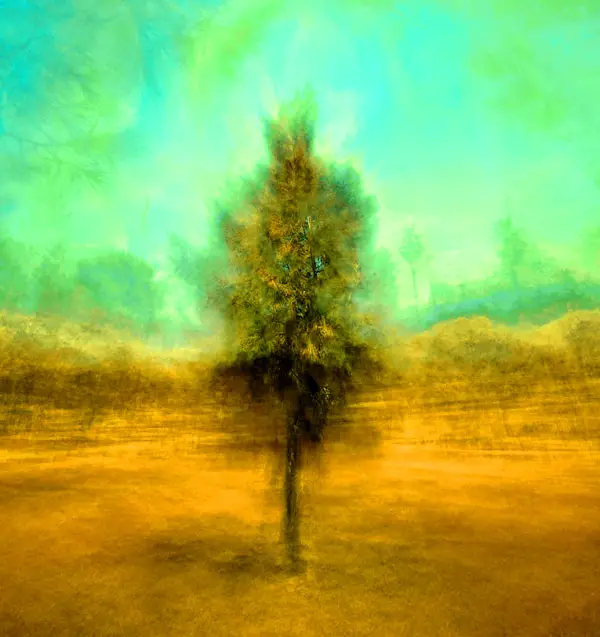
Marketing Your AI Photography Business
Alright, you’ve created some killer images. Now it’s time to get them out into the world and start making some money. But where do you start?
Building a Strong Online Presence
First and foremost, you need to establish your online presence. This is your digital storefront, your chance to showcase your work and attract potential clients. Start with a website. This is your home base, where you can display your AI portfolio, share your story, and provide ways for people to get in touch. Make it visually stunning, easy to navigate, and optimized for search engines. But don’t stop there. Grow your circle far and wide with the magic of social media. Platforms like Instagram, Twitter, and Facebook are powerful tools for connecting with your audience and promoting your work.
Remember to share your process, engage with your followers, join communities of like-minded creators. Build a buzz around your brand. Speaking of social media, let’s dive a little deeper. Each platform has its own unique features and audience. It’s important to tailor your approach to fit the vibe of each one. For example, Instagram is all about the visuals. Let this space be where you parade your eye-popping AI visuals and dive into the making of each masterpiece. Use hashtags to expand your reach and connect with other creators in your niche. Twitter shines when it comes to blasting out speedy updates, jumping into conversations within your field, and connecting with folks who might want to work with you or vice versa. And don’t sleep on LinkedIn. It may not be the sexiest platform, but it’s a goldmine for B2B connections and professional opportunities.
Collaborating with Influencers
Another way to get your work in front of a wider audience is by collaborating with influencers. These are people who have already built a following in your niche, and their endorsement can be a huge boost for your brand. But don’t just go for the biggest names with the most followers. Look for influencers who align with your values and aesthetic, and whose audience is likely to be interested in your work. Make the first move by sending a customized pitch, highlighting all the good stuff both sides stand to gain from working together. Maybe you create custom AI-generated images for their next campaign, or they feature your work in a sponsored post. Get creative with it.
Implementing SEO Strategies
Finally, don’t forget about SEO. Optimizing your website and social media profiles for search engines can help new clients discover your work organically. Do your keyword research to find out what terms people are searching for in your niche. Incorporate those keywords naturally into your website copy, image alt tags, and social media posts. But don’t keyword stuff. Focus on creating high-quality, valuable content that genuinely helps your target audience. That’s what Google’s helpful content update is all about. And while you’re at it, don’t neglect your metadata. This is the title, description, and tags that show up in search results. Make them clear, compelling, and click-worthy. Remember, SEO is a long game. It takes time and consistency to see results. Trust me on this one; the grind truly has its rewards. Organic search traffic is the gift that keeps on giving.
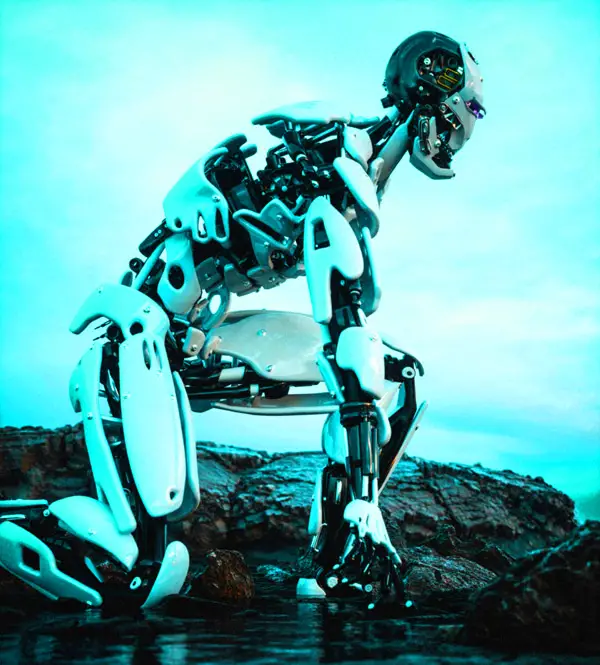
Case Studies: Successful AI-Generated Photography Businesses
AI is revolutionizing the photography industry, and some businesses are already capitalizing on this emerging technology. Take Getty Images, for instance. They’ve embraced AI-generated content, offering a wide range of stock photos created using artificial intelligence. But it’s not just about generating images from scratch. Tools like ZMO Remover allow photographers to easily erase unwanted elements from their photos, saving them hours of tedious editing work. This frees up valuable time that can be spent on more creative and strategic aspects of their business. Even writing about photography has become more efficient with AI assistants like ChatGPT. Photographers can use these tools to generate engaging blog posts, product descriptions, and social media captions, all while maintaining their unique voice and style.
“AI has been a game-changer for my photography business. By using tools like Midjourney and ChatGPT, I’ve been able to create stunning images and compelling content in a fraction of the time it used to take me. This has allowed me to take on more clients and grow my business in ways I never thought possible.” – Sarah, AI-savvy photographer
Imagine this – with AI by their side, photographers aren’t just taking pictures; they’re speeding up tedious jobs, unlocking new levels of creative potential and watching as profits climb. Honestly? All those incredible tales of triumph tell us something loud and clear – there’s nothing ‘just-for-now’ about AI. Photography ventures are using this tech wizardry to seriously stand out on the internet stage. And you need to embrace it to stay on top of making money.
Future Trends in AI Photography
The future of AI in photography is incredibly exciting, with new tools and techniques emerging all the time. One trend to watch is the increasing sophistication of AI art generators like Midjourney and DALL-E. These tools are becoming more and more adept at creating highly detailed, realistic images based on simple text prompts. Watch this space because as these smart tools improve, your favorite visual creators are about to drop some jaw-dropping work. Imagine being able to generate a photo of a specific location, event, or product without ever having to pick up a camera. But AI isn’t just about generating new images from scratch. We’re also seeing the development of powerful AI-driven editing tools that can automatically enhance photos, remove blemishes, and even change the style or mood of an image with just a few clicks.
As these AI tools become more accessible and user-friendly, we can expect to see more and more photographers incorporating them into their workflows. And they are worth it, think of it as leveling up in your photographic journey. Imagine stepping into an era where photos boosted by AI aren’t oddities—they’re what everyone expects. Of course, there will always be a place for traditional photography skills and techniques. Getting cozy with AI and mastering what it offers means you’ll likely thrive in the years ahead. The future of photography is AI-powered, and it’s an exciting time to be a part of this rapidly evolving field.
FAQs
Can I sell photos created by AI?
Absolutely. You can sell AI-created photos as stock images, art prints, or NFTs, just make sure you own the rights.
Can you make money with AI images?
Yes. Selling stock photos, creating custom commissions, and launching print-on-demand products are great ways to profit from AI images.
How is AI being used in photography?
AI revolutionizes photography by generating unique images, enhancing photo quality, and automating editing tasks for photographers.
How to use AI to earn money?
Leverage it for creating exclusive content like digital art or offering personalized services such as consulting on using these technologies.
Conclusion
So, there you have it – my top tips for using AI to make money in photography. From selling stock photos to creating custom commissions, the possibilities are endless. And the best part? You don’t have to be a tech wizard to get started and it will just get easier, so start now.
AI is here to stay, and it’s time for photographers to embrace it. With the right tools and strategies, you can take your business to the next level and start earning more than ever before.
So what are you waiting for? Start experimenting with AI-generated images today, and watch the money roll in. Trust me, your bank account (and your clients) will thank you.




